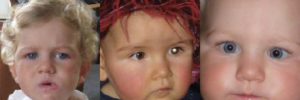This website uses cookies so that we can provide you with the best user experience possible. Cookie information is stored in your browser and performs functions such as recognising you when you return to our website and helping our team to understand which sections of the website you find most interesting and useful.
Eye conditions
A glint or squint should make you think
How to recognise early signs of eye problems in babies and young children.
Looking after your baby can be overwhelming. There is so much to learn and know.
Like all parents, you want the best for your baby. You will spend many hours looking at your baby’s eyes and taking lots of photographs.
What you notice can be very important.
This information, compiled by researcher and clinical orthoptist Dr Sandra Staffieri, will help you recognise early signs of eye problems in children.
What can my baby see?
Vision develops from birth to 7 years. Any eye problem during this time can affect your baby’s vision development.
Early diagnosis and treatment provides the best chance for vision to develop normally.
Age |
Milestone |
| Birth | Reacts to bright light
Attracted to faces Occasionally or briefly cross-eyed |
| 1 month | Looks at faces
Starts following moving objects Starts to return your smile |
| 2 months | Recognises your face
Follows moving objects easily |
| 4 months | Can focus on toys
Begins to reach and grasp toys Eyes should be straight at all times and move freely in all directions |
| 12 months | Picks up small objects with thumb and forefinger |
| Up to 7 years old | Sharp vision continues to develop
Development of 3D vision |
My baby looks cross-eyed
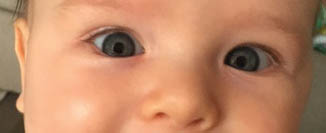
It is normal for your baby’s eyes to look cross-eyed (eye turn/squint) for very brief periods as he learns to use them together.
By 4 months, your baby’s eyes should be straight at all times. Any eye turn that continues beyond this age, even if it comes and goes, should be checked by your doctor.
Cross-eyed or optical illusion?
Sometimes, the wide bridge of your baby’s nose can make it look like your baby’s eye is turning inwards.
This can be more obvious when your baby looks to the side. As their face grows, this cross-eyed appearance will disappear.
Is my baby’s eye turning?
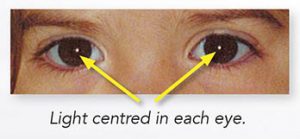
It can be very confusing to know if an eye turn is really there. Here’s how you can check for yourself:
- Hold baby’s head straight.
- Using a toy to attract your child’s attention, shine a torch 30cm from their eyes.
- If the light appears in the centre of each eye, there is no eye turn.
If you are unsure, ask your health nurse or doctor.
When is an eye turn a problem?
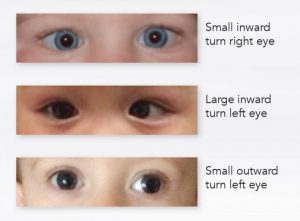
An eye turn can be:
- In either eye
- Inwards or outwards
- Small or large
- Noticeable some or all of the time
You will not necessarily notice whether your baby‘s vision is developing normally just by how your baby behaves.
Any type of eye turn can either be:
- Caused by poor vision in one eye or;
- Result in your baby’s vision not developing properly (amblyopia)
You should mention any family history of eye problems to your Health Nurse or doctor as this can also be very important.
An eye turn can be a sign of a more serious health problem – even if you can’t see it all the time. It is important to have your child examined promptly by your doctor.
Read more information about eye turns in children.
My baby’s eyes look ‘red’ in photos

You will be used to seeing ‘red eyes’ in your photographs. They occur because of the way light is being reflected in the eye.
This is normal.
What if I see a white pupil?
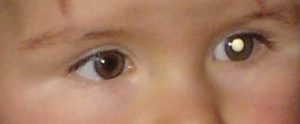
White pupils can sometimes appear in photographs taken with a smartphone or can be caused by the angle at which the photo is taken.
A white pupil, or ‘glint’ may also appear very briefly at different times:
- At night during a feed
- Lying on the change table
- Looking up at you at bath time
Rarely, but importantly, a white pupil can be a serious eye problem.
How to check for a white pupil
If you have taken a photograph of your child and you see a white pupil, follow these instructions first.
Photos should be taken with a regular camera (not a smartphone).
- Switch the red eye reduction function OFF.
- Switch your camera flash function ON.
- Turn the lights down in the room – so that your child’s pupils can widen a little.
- Switch off any table lamps or TV to avoid unwanted reflections.
- Hold your camera about 4 metres from your child and use the zoom to focus on your child’s head.
- Take several photos – front on and from the side, even looking in different directions. You could use a toy to distract your child or make them look where you hold the toy.(even an iPad or smartphone with images or video your child likes to watch).
- Review your photos carefully.
If you still see the white pupil or any abnormality you are concerned about, make an appointment to see your GP and show the photos you have taken. The GP will examine your child and recommend seeing a specialist if it is necessary.
Read more information about white pupils in children.
Not sure if there’s a problem?
If you have noticed an eye turn/crossed eye or are worried about a white pupil in your baby, you should see your:
- Family doctor/GP
- Maternal child health nurse
- Optometrist
They will check your baby’s eyes and decide if there is a problem that needs more testing by an eye specialist.
You can also download this pamphlet that will help you recognise early signs of eye problems.

